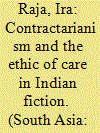|
|
|
Sort Order |
|
|
|
Items / Page
|
|
|
|
|
|
|
| Srl | Item |
| 1 |
ID:
120706


|
|
|
|
|
| Publication |
2013.
|
| Summary/Abstract |
Through close readings of recent fiction from English, Hindi and Kannada sources, this paper analyses the feminist ethic of care with reference to adult daughters caring for their critically-ill or dying mothers. The discussion focuses on problems associated with the care ethic and examines some of its assumptions, particularly its inability to account for the emotional complexity of adult caregiving relationships, which can make the invocation of relationality difficult; its focus on responsiveness to needs, such as those of helpless infants, which prevents adequate engagement with ideas of reciprocity; and, finally, its extraction of the caregiving relationship from the network of social and familial relationships in which it is embedded. Alongside my critique of the ethic of care, I will also examine the extent to which mainstream moral concepts, such as rights and contracts, may continue to be relevant to the dynamics of intergenerational relations in old age.
|
|
|
|
|
|
|
|
|
|
|
|
|
|
|
|
| 2 |
ID:
169065


|
|
|
|
|
| Summary/Abstract |
This article considers the textual importance of matricide in Kirino Natsuo’s 2004 novel Real World. On the one hand, Kirino deploys the death of the maternal figure, which is committed by a teenage male, to critique systemic violence against women. On the other hand, she uses the death – which occurs prior to the events of the novel – to index the ways in which Japanese youth navigate recessionary Japan. This article’s analysis of the novel demonstrates the idea that? although life after the recession has been consistently defined by rampant rejection of Japanese hegemony, including the sustained questioning of home and school life, interpellation is still a practical necessity. In Real World (based loosely on a real-life incident), the teenage killer and the high school girls who help him evade capture are ultimately punished for their transgression of social norms; Worm, as the killer is known, is apprehended by the police, and the friendship that binds the girls together is fractured beyond repair. This article thus identifies a conservative pulse in this writer’s work that, on the surface, reads almost like a celebration of dangerous living.
|
|
|
|
|
|
|
|
|
|
|
|
|
|
|
|
|
|
|
|
|